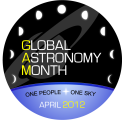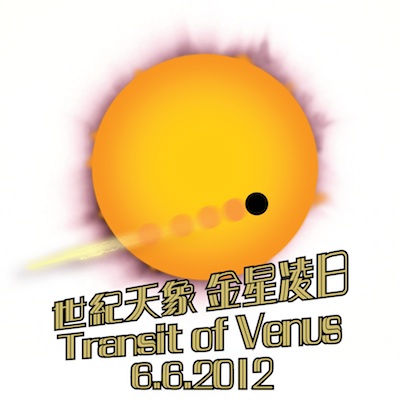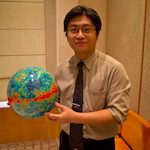GAM 2012 Blog
|
April 2 By Sze-leung Cheung |
Back to the GAM Blog |  |
| Welcome to the GAM blog, although it’s in April, but I must say, we should get prepared for the coming historical and last chance of the Transit of Venus event in June. | ||
What is Transit of Venus?
 I don’t want to spend too much time here to explain what is Transit of Venus, basically it’s a very rare occasion that the three bodies – Sun, Venus and our Earth are align in a straight line, from the viewpoint on our Earth, you can see Venus pass in front of the Sun’s surface. This is the same way that solar eclipses are happened, but this time, Venus “eclipsed” the Sun instead of the Moon.
I don’t want to spend too much time here to explain what is Transit of Venus, basically it’s a very rare occasion that the three bodies – Sun, Venus and our Earth are align in a straight line, from the viewpoint on our Earth, you can see Venus pass in front of the Sun’s surface. This is the same way that solar eclipses are happened, but this time, Venus “eclipsed” the Sun instead of the Moon.
I think nobody will deny that it is a golden opportunity to promote astronomy and science, since it is the last chance in our life time. If anyone misses it, the next transit is in year 2117, unless human cryopreservation is invented, most of us will not be there. This is the number one attraction, you know, media always love to promote these “once-in-a-lifetime” events.
However, in reality, if you compare the image of the transit with a solar eclipse, people usually would give you almost the same response - “it’s so small!” Yes, it’s true. In terms of visual appearance, Venus is much smaller in its apparent size compared to the Moon, and thus it’s less appealing. So we should put one step further, we should also incorporate the consideration of the transit in terms of scientific significance.
Before the time when Uranus was discovered, the absolute scale of the universe is yet to be defined, at that time in the early 18th century, we only knew the relative scale of the solar system in terms of the Astronomical Unit (the Sun-Earth distance), people at that time only guess how large 1 AU is without any solid proofs. It was only known until the time Transit of Venus happened, when scientists organized many expeditions to time the transit of Venus events in different positions, such that the difference in timing of the transits between different places could pin down the exact Sun-Earth distance and hence the dimension of the solar system. It was possible because astronomy has become an organized science, we can call it as“big science” projects, comparable to the Space shuttle and Large Hadron Collider at the present time. It is why the transit of Venus was so important. (If we want to read more, there are much more information available on these websites - http://transitofvenus.nl/ and http://www.transitofvenus.org/. ) Unfortunately, we have almost forgotten this important piece of history nowadays. But to us, I think it’s still an excellent occasion to arouse the public interest in astronomy and science.
First, we understand that June 6 is a Wednesday, a weekday, it is a school day and also a working day. Second, the transit will start at 6am and end at 1pm locally, last for 6 hours in total. We followed these two important conditions to set our program for the event. Sidewalk astronomy and public lectures are definitely a must that we have planned for, but how to mobilize the public to join the event during the school day and working day is the major challenge. In view of these, we offered two options, first we targeted at all the schools in Hong Kong and invite them to establish an observational site at or nearby their school, we will provide teacher trainings and some degree of support, though limited, to them. Second, we establish a number of observational stations across the city at different distinct to encourage the public to participant.
Moreover, we will set a central observation station at the city center, there will be a major sidewalk event, and in together, we will setup roadshow counters to highlight and demonstrate the science, mathematics and even history behind the transit, using models, exhibitions. Students and helpers will standby there to explain how science was done in the past, and how we can use the transit to measure the solar system to the public. We have recruited an army of university students, they will help us to go to the schools and different observation station, to man the counter and be a science ambassador to explain the science working behind the transit to the public.
Invitation for Joint Webcast
Last but not least, we would like to connect international partners to perform joint webcast, would you be interested to join together and share our events on screen each other? Please do feel free to contact me at [email protected] . If you want to learn more about us, please kindly visit http://roadshow.science.hku.hk and http://transitofvenus.hk .
|
|
Bio: Sze-leung Cheung is the Outreach Officer and Science Instructor of The University of Hong Kong, he was the coordinator of IYA2009 Hong Kong node. |








